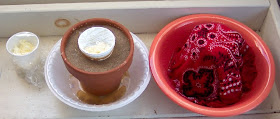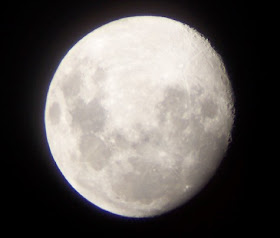In Lecture 12 of The Joy of Science, Prof. Robert Hazen tells the story of the first electric battery. In 1799, Alessandro Volta was the first person to devise a way to chemically generate electricity without the use of frogs. I decided to try this experiment at home.
 |
| Luigi Galvani and his wife Lucia discovered that dissecting frog legs with a scapel near an electrostatic generator caused the muscles to jump. |
We had tried to make a Lemon Battery back when we were doing chemistry. We were not successful. I was all ready to go out and buy a bag of lemons and try again, when I came upon this Tiny Lemon Battery Instructable. The author shows many different ways to create what one commenter dubbed "nano-batteries" using the bare minimum of materials and only a few drops of lemon juice. Since I had a bottle of lemon juice in the fridge, and the other materials were easily scrounged from our science and art supplies, we were able to make a few different types of batteries in the course of a morning -- two of which actually worked!
Method One: Copper and Aluminum Foil Batteries
Materials
copper foil (available in craft stores)
aluminum foil (from the supermarket)
facial tissue (Kleenex)
multimeter or voltmeter
disposable plate (to work on)
dish soap or lemon juice
- Cut a piece of copper foil about 1 inch by 2 inches.
- Separate the tissue into layers. Cut a piece about 1 inch by 3 inches.
- Cut a piece of aluminum foil about 2 inches square.
- Layer the materials so that the aluminum foil is on the bottom, the tissue is in the middle, and the copper is on top. Fold the aluminum foil so that the edges wrap around the tissue and copper foil as shown above. This is your battery.
- Place the battery on a plate. Soak the paper with either dish soap or lemon juice. (We tried one of each.)
- With your voltmeter, measure the voltage generated by placing one terminal on the copper and one on the aluminum. We got up to half a volt of electricity from our primitive Galvanic cell batteries.
Method Two: Copper and Zinc Wire Battery
Materials
2 inch long piece of zinc-plated steel wire ("galvanized" picture-hanging wire works well)
4 inch long piece of uncoated copper wire, as thin as possible
a layer of Kleenex (see above)
disposable plate
lemon juice or dish soap
- Cut a piece of tissue about 1 1/2 inches long and 1/2 inch wide.
- Wrap the tissue layer around the steel wire, leaving the ends uncovered.
- Coil the copper wire around the tissue, being sure not to touch the steel wire inside. Make the coils as close together as possible without overlapping.
- Soak the paper in lemon juice or soap as above and measure the voltage!
















